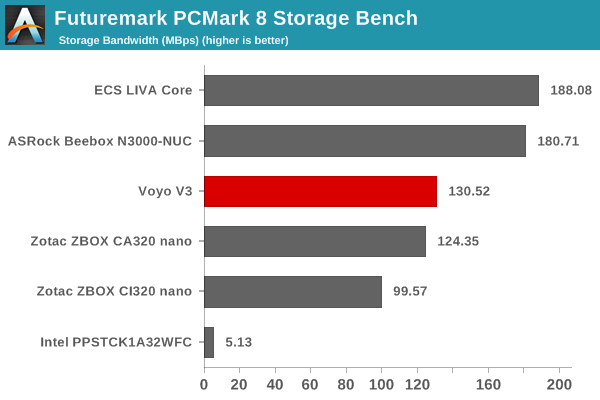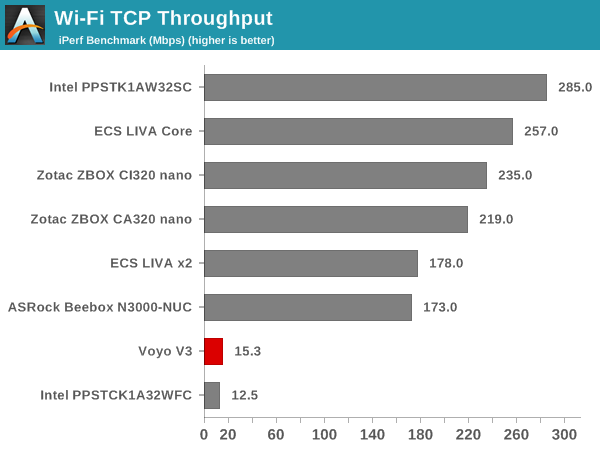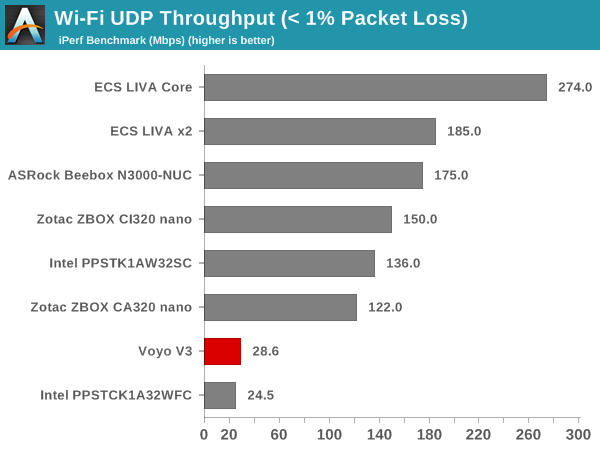Voyo V3 Review - A Fanless Intel Atom x7-Z8700 (Cherry Trail) mini-PC
by Ganesh T S on March 1, 2016 8:00 AM EST- Posted in
- Systems
- Intel
- Atom
- Passive Cooling
- Mini-PC
- Cherry Trail
Networking and Storage Performance
Networking and storage are two major aspects which influence our experience with any computing system. This section presents results from our evaluation of these aspects in the Voyo V3.
There is no doubt that the most interesting part of the Voyo V3 specifications is the presence of a bonafide M.2 SATA SSD. At the price point of the system (around $200), most consumers would only be expecting disappointing eMMC storage. As we saw during the teardown process (detailed on the first page), the system includes a 128 GB M.2 2242 SSD made by FORESEE. There are two NAND flash packages (packaged by FORESEE themselves - so, we do not have visibility into the NAND flash vendor). The controller is the DRAM-less Silicon Motion SM2246XT. As per specifications, it doesn't support TLC flash. Hence, we can say with a high degree of confidence that the FORESEE SSD in the Voyo 3 has 128GB of MLC flash.
In terms of evaluation of the storage component, one option would be repetition of our strenuous SSD review tests on the drive(s) in the PC. Fortunately, to avoid that overkill, PCMark 8 has a storage bench where certain common workloads such as loading games and document processing are replayed on the target drive. Results are presented in two forms, one being a benchmark number and the other, a bandwidth figure. We ran the PCMark 8 storage bench on selected PCs and the results are presented below.


Daily workloads (of the type tested by PCMark 8's storage bench) have barely noticeable differences between the SSDs in these UCFF PCs when it comes to the storage subsystem score. However, the presence of a DRAM-less controller does bring down the storage bandwidth numbers for certain workloads. That said, for the types of workloads that the CPU in this system is suitable for, the SM2246XT-equipped FORESEE SSD is more than enough.
On the networking side, we restricted ourselves to the evaluation of the WLAN component. Our standard test router is the Netgear R7000 Nighthawk configured with both 2.4 GHz and 5 GHz networks. The router is placed approximately 20 ft. away, separated by a drywall (as in a typical US building). A wired client is connected to the R7000 and serves as one endpoint for iPerf evaluation. The PC under test is made to connect to either the 5 GHz (preferred) or 2.4 GHz SSID and iPerf tests are conducted for both TCP and UDP transfers. It is ensured that the PC under test is the only wireless client for the Netgear R7000. We evaluate total throughput for up to 32 simultaneous TCP connections using iPerf and present the highest number in the graph below.

In the UDP case, we try to transfer data at the highest rate possible for which we get less than 1% packet loss.

Before discussing these results, it is time to bring up yet another ridiculous advertised aspect of the Voyo V3. Almost every shopping site listing the unit claims dual-band Wi-Fi along with Broadcom's 5G Wi-Fi logo (obviously unauthorized use). The WLAN chipset used in the Voyo V3 is the Realtek RTL8723BS, a 1x1 2.4GHz 802.11n + Bluetooth 4.0 radio that talks to the host SoC over SDIO. As one can see from the above two graphs, it is matched in the hall of shame only by the poor Wi-Fi on the Bay Trail-T Compute Stick. To add insult to injury, the size of the unit and the I/O integrated in the SoC ensure that there is no wired networking capability / RJ-45 port in the Voyo V3. Users will need an external USB 3.0 - Ethernet adapter, if a wired connection is desired.











69 Comments
View All Comments
Pissedoffyouth - Tuesday, March 1, 2016 - link
I wish Intel could sort out it's Atom Linux support. Something like this with Linux support would be fantastic. It's been like 3 years and my Asus t100 Baytrail still doesn't work properly 100% without invasive patches for its kernel.BrokenCrayons - Tuesday, March 1, 2016 - link
I've had endless problems getting Linux working on an Asus X205TA that's got a Bay Trail to the point where I've given up on it and it's basically a Windows paperweight sitting in a drawer. HP was a lot better/easier with the Stream 11, but even it isn't as easy as it ought to be to get a proper operating system installed. The hardware specs on these low end Atoms with their passive cooling and low price make them perfect candidates for Linux. I'm not one to spread conspiracy theories, but I think that there's been active work put into the idea of preventing people from easily abandoning Windows on cheaper systems. After all, if Microsoft is giving the OS away for free, they need to recoup their costs through targeted advertising and the Windows Store so the last thing Microsoft would want is the end user population hopping onto an OS where they don't reap any financial return.PsychoPif - Wednesday, March 2, 2016 - link
"I'm not one to spread conspiracy theories, "Except you just did :)
Unless you can provide any shadow of a doubt, I'll keep beliving it has more to do with the fact that Linux is too small of a market to warrant the cost for the hardware maker.
BrokenCrayons - Wednesday, March 2, 2016 - link
I might be mistaken, but the number of computing devices running a Linux kernel is currently higher than those running a Microsoft built kernel. While a lot of that is due to Android, there's also super computer dominance and other fringe markets. Because of Microsoft's recent missteps with Windows 8's user interface and privacy concerns that arose due to Windows 10 telemetry, I think there's a reason for shareholders to be concerned. It didn't take that many years for the Linux kernel to reach a dominant state in the mobile sector. Yes, on desktop and laptop PCs, the market share is about 1.7% running Linux, but that traditional computing model is mature and even in a state of decline as mobile devices running alternative operating systems are apparently taking sales. As handsets have proven, change can happen quickly. It's in Microsoft's best interest, particularly with Secure Boot, to implement mechanisms that help to achieve ecosystem lock-in.Flunk - Tuesday, March 1, 2016 - link
I don't think it's Intel's problem that the Linux kernel has compatibility issues with their hardware. Microsoft initially had some problems with bay trail and cherry trail too, but they fixed their issues. The issues are mostly concerned with certain hardware things these SoCs no longer have that OSes assume x86 chips have. It's not an issue with the hardware.Flunk - Tuesday, March 1, 2016 - link
Also, I should follow this up with the standard open-source argument. If you want bay trail/cherry trail support then you should write it yourself.eek2121 - Thursday, March 3, 2016 - link
I'm not normally one to agree with a troll, but thank you Flunk, as someone who has read that very line across many different open source projects...you made my night. I said this 15 years ago, and i'll say it again. The open source world has 3 problems when it comes to open source adoption. The biggest one is the asshole community. Fix that issue and you'll go a long way towards widespread open source adoption. Unfortunately, there is no shortage of assholes out there...so good luck!sprockkets - Tuesday, March 1, 2016 - link
I'm on such a cpu right now, the Pentium 3700. About the only issues with Linux are video, and the drivers for it are from Intel, open source as well.What is weirder is that video wise, Android works way better than typical Linux. Probably because it doesn't use X. I'd look into Remix OS or the Android x86 project. Best part of the latter is you'll have no issue with updates or upgrades vs the typical android tablet.
extide - Wednesday, March 2, 2016 - link
No, it is an issue with Intel because they should be submitting the patches and drivers to make stuff work properly.Camikazi - Wednesday, March 2, 2016 - link
But it's Linux, if it doesn't work you can fix it yourself, isn't that the big thing about it? I don't think Intel should submit anything to make it work, they do it if they can and if they want to other than that you are on your own making it work.